Menu

Did you know the EU wants to cut its net greenhouse gas emissions by 55% by 2030? This move shows the big role countries like Ireland have in fighting climate change. Ireland mirrors the EU’s green targets to create a clean future. It follows the European Green Deal to hit EU-wide zero emissions by 2050.
The European Green Deal aims to change sectors like energy, transport, and farming. It lays the groundwork for Ireland’s green evolution. Ireland’s green laws, driven by EU plans, are the result of teamwork. They aim for high environmental quality and to be a top green economy.
Ireland aims to slash greenhouse gas emissions by 51% by 2030 and reach zero by 2050. It’s all about playing its part at home and in the bigger EU picture. Ireland’s commitment means it goes beyond the EU’s tough green rules. This is done by using green plans and passing important laws.
The European Green Deal is a big plan by the European Commission. It covers many areas to make Europe more green and increase economic growth. Its main goal is to have as little negative impact on the climate as possible by 2050. This plan is crucial for dealing with climate change and set to lead the way in the world.
One big focus of the European Green Deal is to cut down on all greenhouses gases by 2050. This aims to make the EU the first climate friendly continent. The EU has also set a goal to lower these emissions by at least 55% by 2030.
This will be backed by funds from the EU’s financial plans, making it a serious effort. A lot of money from the EU budget will be used to make these goals real.
The plan also talks about using resources in a smarter way, especially in areas like transport, energy, and farming. It focuses on producing less waste, using resources better, and making sure everyone follows green laws.
It includes plans to make our food systems greener and make buildings more energy-efficient. Making steel without polluting and increasing the use of electric cars are also part of the big picture.
The EU is helping areas that rely on coal and oil with a lot of money to change for the better. This shows a strong commitment to helping everyone move towards a greener future together.
The President of the European Commission, Ursula von der Leyen, points out the importance of the European Green Deal. She says it’s critical for saving our planet and also a big chance for economic growth. This plan is at the heart of EU’s vision for a green and prosperous future, showing a strong belief in sticking to strict green laws.
The EU has a big plan for nature with its Biodiversity Strategy for 2030. It wants to protect Europe’s natural places and creatures. This is a key part of the European Green Deal, helping to fight climate change and other threats.
This plan focuses on creating more protected areas, both on land and at sea. It aims to stop the loss of nature and to fix damaged ecosystems. These places are also great at storing carbon.
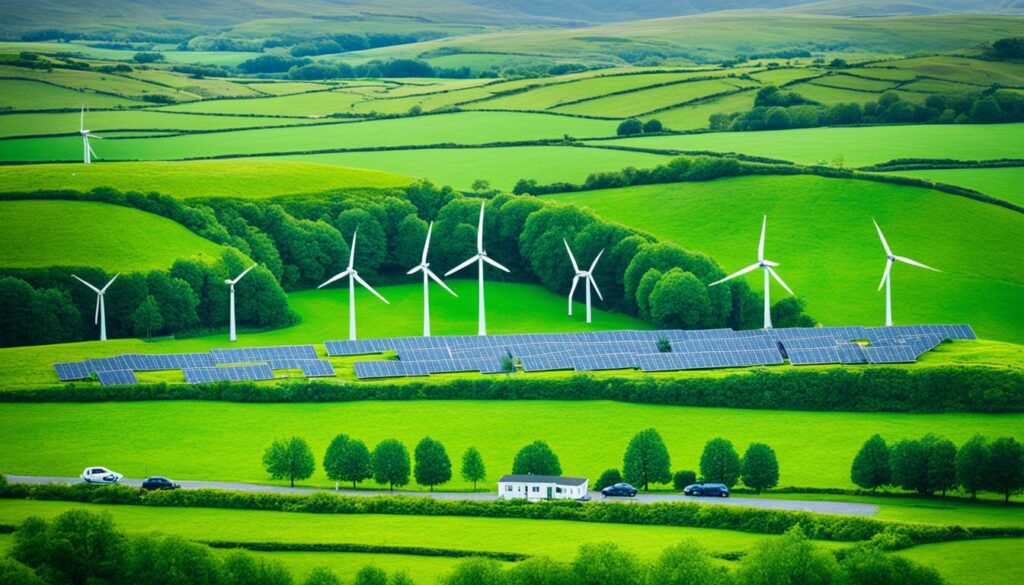
One big goal is to stop losing nature and start to fix it by 2030. The EU wants to restore 80% of key areas like wetlands and forests. They are keeping an eye on over 1,300 species and 230 habitats to guide this work.
Places like Natura 2000 help a lot with this. They are special zones protected to keep unique plants and animals safe. This is part of meeting tough EU environment rules.
Core to the strategy is a new law that pushes for nature restoration in a big way. This directive aims to bring ecosystems back to health, with clear targets for everyone to follow. It also helps with getting the money needed and with better ways to govern this work.
The strategy is using new online tools to keep track of how things are going. Policymakers and the public can use them to see the progress. This shows how everyone is working together to make things better.
Ireland is on board with the EU’s plan. It’s working hard to protect nature and support biodiversity. By following these strategies, Ireland shows its eco-friendly promise and its dedication to keeping the environment in good shape, just like the rest of the EU.
The Farm to Fork Strategy is a key part of the European Green Deal. Its goal is to develop sustainable food systems all over the EU. This strategy aims to create food in ways that are good for the planet, fair, and healthy. This approach helps ensure that we can rely on our food sources for the long term. Ireland is leading the way by supporting farmers who use methods that are good for the climate and the environment.
Nearly one-third of the world’s greenhouse gas emissions come from food systems. They also use a lot of our natural resources. That’s why we need to change how we produce our food. The Farm to Fork Strategy wants to move us towards methods that don’t harm the planet. It also focuses on making sure we all have enough food, good nutrition, and healthy lives. And it wants farmers to earn a fair living while keeping food affordable.
In the past few years, new technologies and growing awareness have made people more interested in sustainable food systems. At the same time, the European Union is getting ready to make laws that support this shift. These new laws will help us switch to methods that are better for the planet. They show that the EU is serious about making global changes in how we produce food. This effort involves working with other countries and setting new trade rules.
The Farm to Fork Strategy’s bigger goal is part of the European Green Deal. The EU aims to be climate-neutral by 2050. So far, EU agriculture has cut its greenhouse gas emissions by an impressive 20% since 1990. But there are still issues, like too much food waste and people eating poorly. These problems need to be fixed to meet health and environmental goals.
The EU’s steps towards sustainable food are very important. They ensure that our food methods are good for the environment, following environmental legislation Ireland. They also want everyone in the food sector to have a fair chance. This includes making sure farmers earn enough. Right now, a farmer in the EU typically makes much less than someone working in another job. The strategy aims to change this by supporting fair pay for those in the agriculture sector.
In the end, the EU – a big player in global food trade – wants to change food systems worldwide. By pushing for better practices and fairness, it’s showing a strong commitment to planetary health. This is good for the EU and Ireland, as it matches their own sustainability goals.
Ireland is firm in following EU rules on the environment. They are very active in the ‘Fit for 55’ plan. The goal is to cut down greenhouse gas emissions by 55% by 2030. This is against the 1990 levels. It’s a big task that covers many areas, changing Ireland’s policies a lot.
Making less greenhouse gas is key for Ireland to meet the EU’s goal. The ‘Fit for 55’ plan aims to slash emissions in many areas. From factories to what people use in their daily lives, every sector must cut down. This shows Ireland is really serious about helping the EU reach bigger climate goals, like cutting 90% of emissions by 2040.
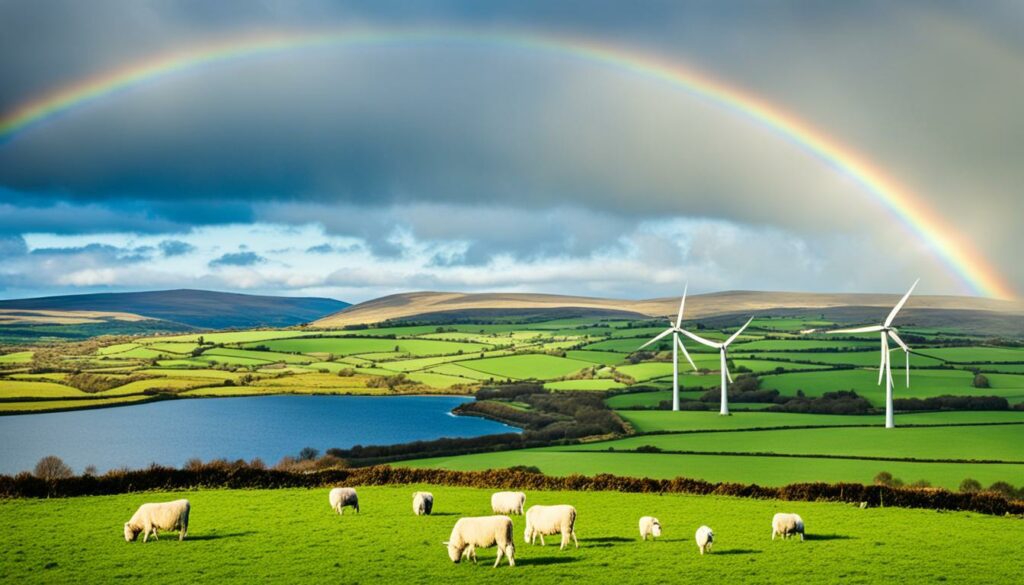
The ‘Fit for 55’ plan looks at the whole economy. It touches energy, transport, building, and farming. By following EU laws, Ireland aims for a green, growing economy. Even with an ‘Insufficient’ score for the EU’s 2030 climate plan, Ireland keeps working hard. This is towards the needed greenhouse gas cuts.
Let’s take a closer look at the breakdown of targets and commitments:
| Target Year | EU Emissions Reduction Goal | Overall Rating |
|---|---|---|
| 2030 | 55% below 1990 levels | Insufficient |
| 2040 | 90% below 1990 levels | Recommended |
Despite the low score, we need to do more. Ireland sticking to these rules is crucial. It helps our country work with the EU on climate goals. We need to try even harder to fight climate change.
The REPowerEU plan aims to speed up the use of renewable energy in Europe. This is to reduce our reliance on fossil fuels. It points out the need to use more renewable energy for energy security and to protect the planet.
The REPowerEU initiative wants to cut how much Europe depends on fossil fuels a lot. In 2022, 39% of Europe’s electricity came from renewables. This was the first time wind and solar power made more electricity than gas. It’s a big step towards cleaner sources of energy.
To make this change happen, there are new ideas like making it quicker to get permits for solar equipment. This makes it easier and faster to start using renewable energy. Ireland is also working on these efforts. It shows the country is dedicated to following EU plans for a greener energy future.
The REPowerEU plan has a big goal: to cut emissions by 90% by 2040. To get there, the EU plans to use at least 42.5% renewables by 2030. This is a solid start to lower our impact on the environment.
Ireland is also focusing on these goals. It’s working to lower emissions from transportation. Despite a 6% rise in 2022, it’s not giving up on cutting emissions. This renewed focus by Ireland shows a new effort to meet green targets.
| Key Measures | Details |
|---|---|
| Binding Renewable Energy Target | 42.5% by 2030 |
| Electric Vehicle Recharging Points | Over 500,000 across the EU |
| Emissions Reduction Target | 90% by 2040 |
| Average Annual Energy Savings | 1.49% from 2024 to 2030 |
| Permitting Process Streamlining | One month for solar equipment not on natural ground |
Ireland is making a big effort for a fair shift to a green economy. It uses tools like the Just Transition Fund and the Social Climate Fund. These come from EU programmes. They help lessen the impact on people and places hurt by the change.
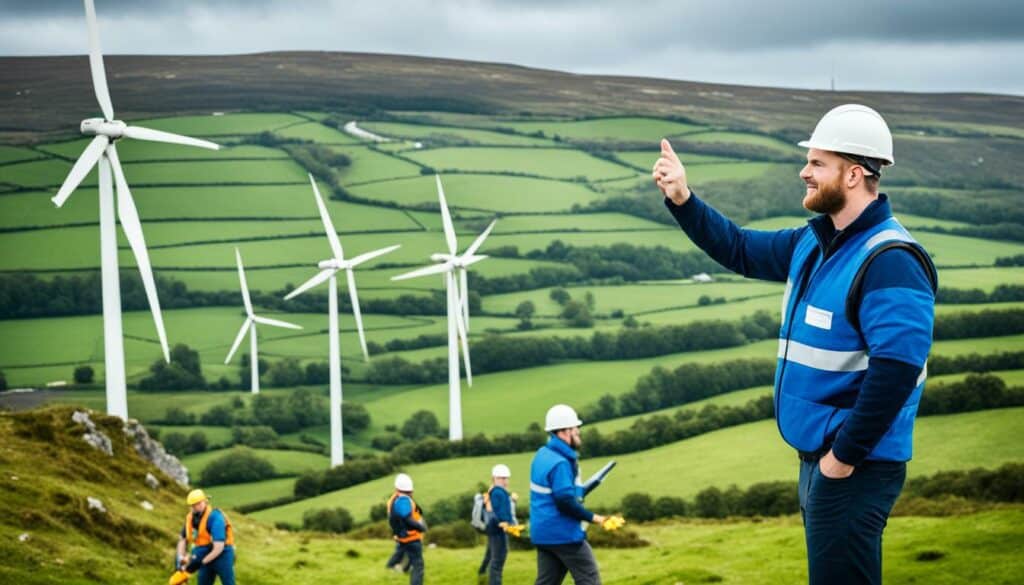
The Just Transition Fund tackles problems in areas and jobs hit hardest by the green shift. It helps make new jobs and teaches new skills. This is for workers from industries that use a lot of carbon.
The Social Climate Fund lends a hand too, but focuses on people struggling with energy bills and climate issues. It wants to make sure everyone gets something good from the green change. This stops the gap between rich and poor from getting bigger.
| Fund | Purpose | Key Beneficiaries |
|---|---|---|
| Just Transition Fund | Restructuring support for carbon-intensive sectors | Workers in coal and heavy industry |
| Social Climate Fund | Financial assistance for households | Vulnerable households facing energy poverty |
Both funds play a key role in making sure the move to a better, greener economy is good for everyone. They look after the needs of those most affected. This shows how Ireland and the EU work together for both the planet and people.
The UN Paris Agreement is a joint goal of all EU countries, including Ireland, to fight climate change. It shows how Europe leads in fighting climate change by setting strong goals. One big goal is to cut greenhouse gas emissions by 55% by 2030. This is a major step toward a cleaner and more sustainable future.
The aim of the UN Paris Agreement is also a sign of Europe’s leadership in green efforts. Take the REPowerEU plan for example. It aims to cut emissions by 90% by 2040. This shows Europe’s serious commitment to solving environmental problems. It also puts the EU in a leading position in the world’s climate talks, inspiring other nations to do more.
The EU is working on a law that would help restore 80% of vital ecosystems in Europe. This move is essential for a stronger environment and steady growth. By doing this, the EU is showing its strong promise to fight climate change on a global scale. It’s not just helping nature but also uniting countries and encouraging new ideas.
| Commitment | Target Year | Goal |
|---|---|---|
| Net Greenhouse Gas Emissions Reduction | 2030 | 55% reduction compared to 1990 levels |
| Restoration of European Ecosystems | Ongoing until targets are achieved | Repair 80% of Europe’s ecosystems |
| REPowerEU Emission Reduction Plan | 2040 | 90% emission reduction |
The EU’s dedication to these goals highlights its key role in global green efforts. Ireland and other countries play a crucial part in this team effort. By working together, they show a strong commitment to protect our planet.
The EU’s journey on environmental policy is highly impressive, leading to big changes in countries, including Ireland. It started with tackling air pollution and water issues with certain rules. This laid the foundation for more detailed policies.
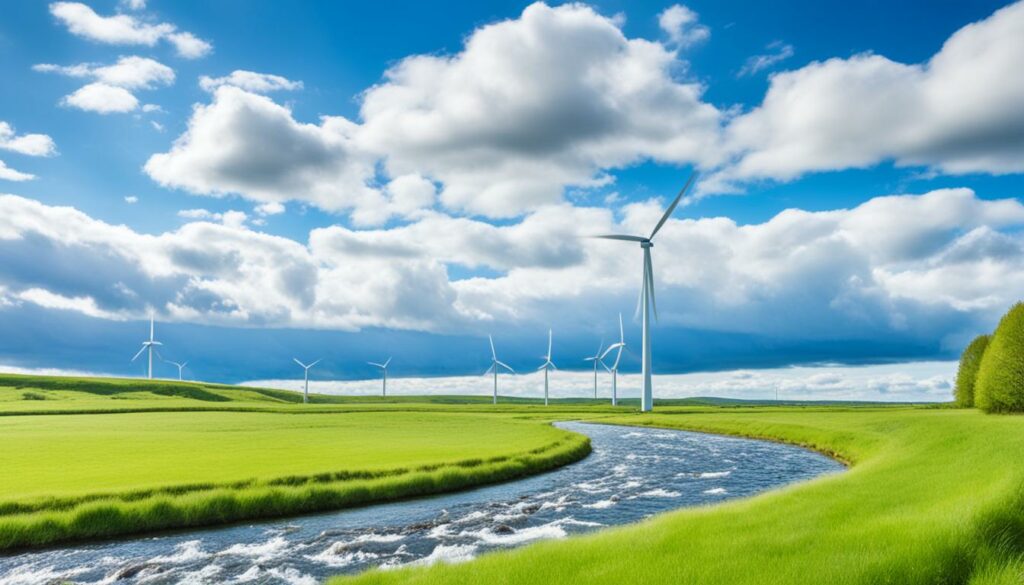
In the beginning, the EU made many European environmental directives. By 2014, pollution from factories was costing over EUR 100 billion a year, showing the need for strong rules. Today, there are about 500 environmental laws, showing how much the EU has done.
In 1986, the Single European Act (SEA) was a big step for the EU’s environmental policies. It recognised the environment’s protection as key. This act made sure all countries were following similar rules. Then came the Maastricht Treaty, adding sustainable development goals to the EU’s main objectives.
| Major Milestones | Impact on Environmental Policy |
|---|---|
| Single European Act | Introduced formal environmental policy, driving standardised regulation. |
| Maastricht Treaty | Integrated environmental protection into the EU’s fundamental objectives, promoting sustainability. |
These key moments shaped the EU’s big dreams for the environment, also affecting Ireland positively. The EU has kept making its policies greener, showing its strong promise for a sustainable future.
The EU wants to ensure Europe’s future is economically, socially, and environmentally sound. It works by setting key challenges for each country to meet, like in Ireland. This way, everyone works together on big issues.
Seven major problems are at the heart of the EU Sustainable Development Strategy:
These challenges are essential for both now and the future. They make sure development today meets peoples’ needs and keeps resources safe for tomorrow.
The EU’s approach pulls efforts from many parts together. For example, the EU Nature Restoration Law wants to fix many natural places across Europe. The Farm to Fork Strategy looks at fair and healthy food systems.
This way, Ireland mixes its different policies to all aim for the same national goals.
| Target Year | Objective |
|---|---|
| 2030 | Reduce net greenhouse gas emissions by at least 55% compared to 1990 levels |
| 2040 | Recommend reducing emissions by 90% |
| 2050 | Achieve climate neutrality across the EU |
The goals show the EU’s plan to become more sustainable. Ireland is working towards these same targets. This helps drive a joined-up development plan for Ireland.
Ireland’s laws on the environment are vital for keeping the country green. They make sure that the government properly looks after the land, water, and air. These laws also help Ireland stay in line with what the European Union wants. There are two main laws that do this job well:
The Environmental Protection Agency Act came into effect in 1992. It set up a strong system for Ireland to manage its environment. Because of this law, the Environmental Protection Agency (EPA) was created. The EPA watches over how our environmental laws are followed. It makes sure everyone does their part to protect the environment.
The Protection of the Environment Act is another important law, passed in 2003. It made sure that Ireland’s rules on the environment matched those of the EU. This law gives Ireland better ways to deal with issues like trash, dirty water, and bad air. By making sure these laws are taken seriously, Ireland shows its strong support for green rules and caring for the Earth.
Both laws build the foundation of how Ireland manages its environment. They help Ireland not only keep up with the EU but also lead in protecting the environment. This shows that Ireland is truly dedicated to being green and sustainable.
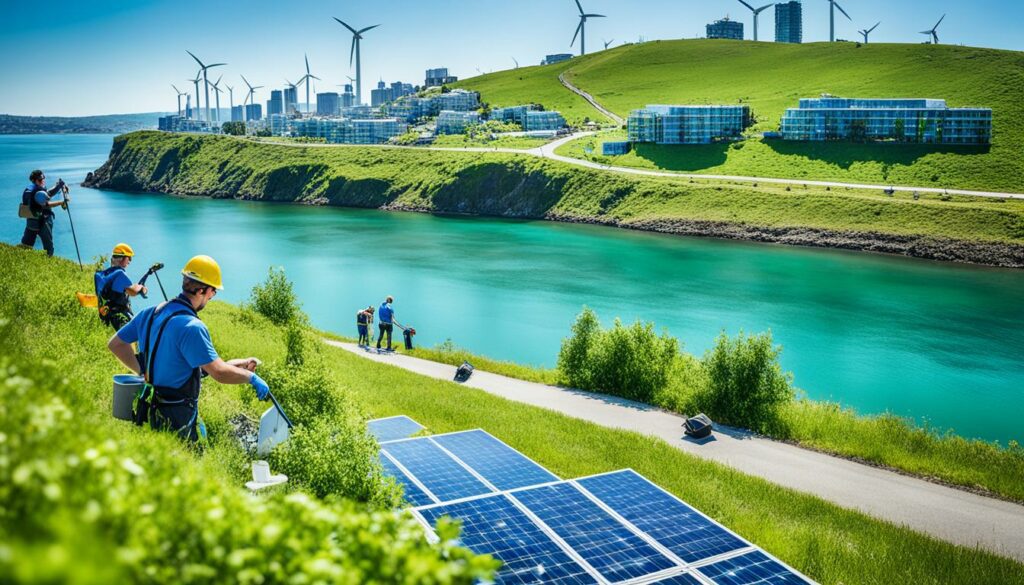
| Legislation | Key Provisions | Authority |
|---|---|---|
| Environmental Protection Agency Act (1992) | Establishment of the EPA, enforcement of environmental laws | Environmental Protection Agency (EPA) |
| Protection of the Environment Act (2003) | Integration of EU directives, enhanced enforcement mechanisms | EPA, Local Authorities |
In Ireland, regulatory authorities are key. They make sure our environment is looked after well. They also see that we follow EU rules on the environment. The Environmental Protection Agency (EPA) and local groups handle these tasks. They work on climate change, managing waste, and protecting nature.
The EPA is very important in keeping Ireland green. It works to follow big EU laws that keep us and our environment safe. By making sure we meet EU environmental laws, the EPA helps save about EUR 55 billion in health and environmental costs every year. Together with national groups, they focus on improving how we deal with issues like pollution and taking care of our natural resources.
Local and regional groups are also crucial for Ireland’s green policy. They help us keep up with EU laws on the environment. They take care of about 20% of EU cases about breaking environmental laws. With extra technical help from the EU, they work better on following environmental rules.
They use things like TAIEX-EIR PEER 2 PEER to learn more and help each other. This makes sure Ireland does well under the EU’s broad environmental laws. It’s all thanks to the hard work of the EPA and our local groups.
| Regulatory Authority | Role in Environmental Governance | Key Contributions |
|---|---|---|
| Environmental Protection Agency (EPA) | Administration and enforcement of environmental regulations | Compliance with EU environmental laws, potential cost savings of EUR 55 billion annually |
| Regional Authorities | Local enforcement and compliance | Addressing environmental law infringements as per European Commission |
| Local Authorities | Community-level oversight and implementation | Enhancing execution of legislation through Technical Support Instrument |
Ensuring that environmental rules are well enforced is key in Ireland to meet EU green standards. The Environmental Protection Agency (EPA) and local groups look after green policies. They use the law to make sure everyone meets tough green rules.
The EPA does thousands of checks on green rules every year. This means everyone must follow these rules, not just a few. The EPA talks regularly with more than 100 companies about reducing harmful emissions. This shows how serious Ireland is about controlling pollution.
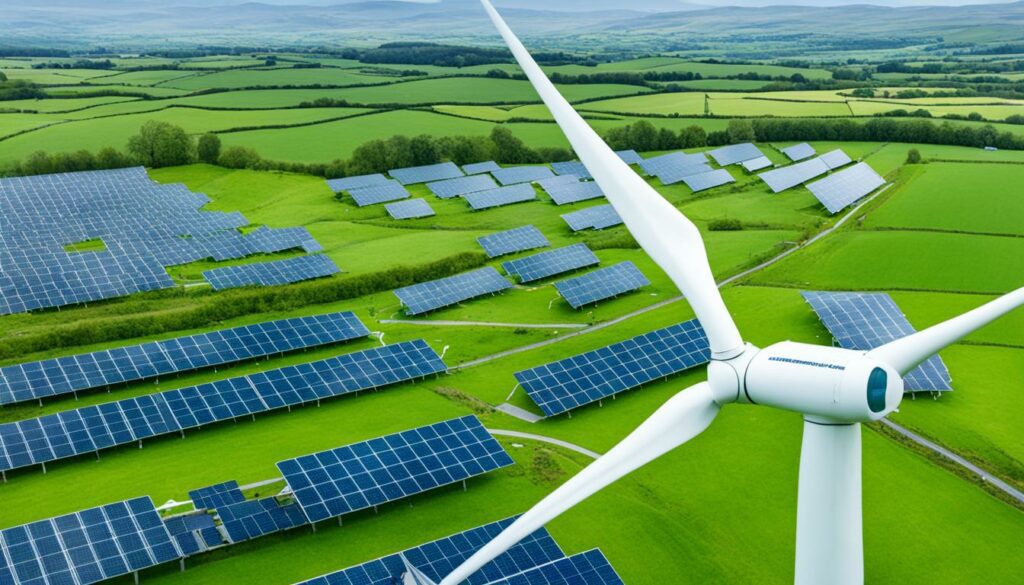
Ireland gets help from the European Commission to improve its green laws. Tools like TAIEX-EIR PEER 2 PEER give support for making changes. Reports like the Environmental Implementation Review help spot and fix any legal gaps. These reviews, starting in 2017, are done for all EU countries, including Ireland.
An expert group from different countries meets twice a year to talk about making more green progress. They focus on laws that help the environment. Working together keeps Ireland on track with EU and national green goals.
The EPA does a lot more than just making sure people follow green laws. They also do research and work on big environmental issues. This includes looking at air and water quality, climate change, and protecting wildlife. Different EPA offices work on these important tasks.
There are also special plans in Ireland for dealing with waste and dangerous waste. These are a big part of meeting the EU’s green rules.
| Key Factor | Details |
|---|---|
| Annual Audits and Inspections | Over 2,000 conducted by EPA (2006-2008) |
| Emissions Coordination | Over 100 companies managed under Emissions Trading Directive |
| Support Tools | TAIEX-EIR PEER 2 PEER |
| Significant Reports | Environmental Implementation Review (2017, 2019, 2022) |
| Key Areas of Focus | Air & Water Quality, Climate Change, Biodiversity |
| Committees | Advisory Committee with 12 members |
Environmental NGOs in Ireland, like An Taisce and Friends of the Irish Environment, are key. They push for strong environmental laws. These groups fight to make sure local actions meet the big goals of the EU. They’ve rallied the public behind green efforts, sparking an Irish passion for eco-activism.
Their work has been studied thanks to Northern Ireland Environment Link (NIEL) and Irish Environment Network (IEN). This study was supported by groups including Community Foundation Ireland (CFI). CFI and Community Foundation Northern Ireland’s (CFNI) ‘All-island fund’ shows wide backing for their cause. This proves the importance of their environmental efforts in Ireland.
Important support has also come from key institutions like QUB and UCD. They’ve worked together through groups like the Environmental Justice Network Ireland (EJNI). Their research, checked by peers, is reliable. It gives strong suggestions to help environmental work in Ireland grow.
Looking ahead, the EU aims to cut greenhouse gases by 55% by 2030, ultimately being climate-neutral by 2050. Important plans are in place, like the Fit for 55 package. These plans are crucial. In line with EU goals, Environmental NGOs in Ireland are essential. They guide and push policies that meet these high aims.
Irish green efforts are clearly very committed. They’ve agreed to big goals of the EU Biodiversity Strategy for 2030. These include repairing 80% of key natural spots in Europe.
| Key Entity | Role | Support |
|---|---|---|
| An Taisce | Advocacy and Policy Influence | Funding from CFI, CFNI |
| Friends of the Irish Environment | Public Mobilisation for Sustainability | Research Support from QUB, Maynooth, TUS, UCD |
| EJNI | Research and Peer Review | Funding from Joseph Rowntree Charitable Trust |
In the end, Environmental NGOs in Ireland do vital work. Their advocacy and projects are essential. They keep Ireland in line with EU green rules. Their efforts keep Ireland proactive and leading on the environmental front.
Ireland has an integrated permitting regime. It brings together various environmental permits. This makes it easier to oversee activities that greatly affect the environment. It blends planning permission with environmental permits, yet they are still separate, making regulations clearer.
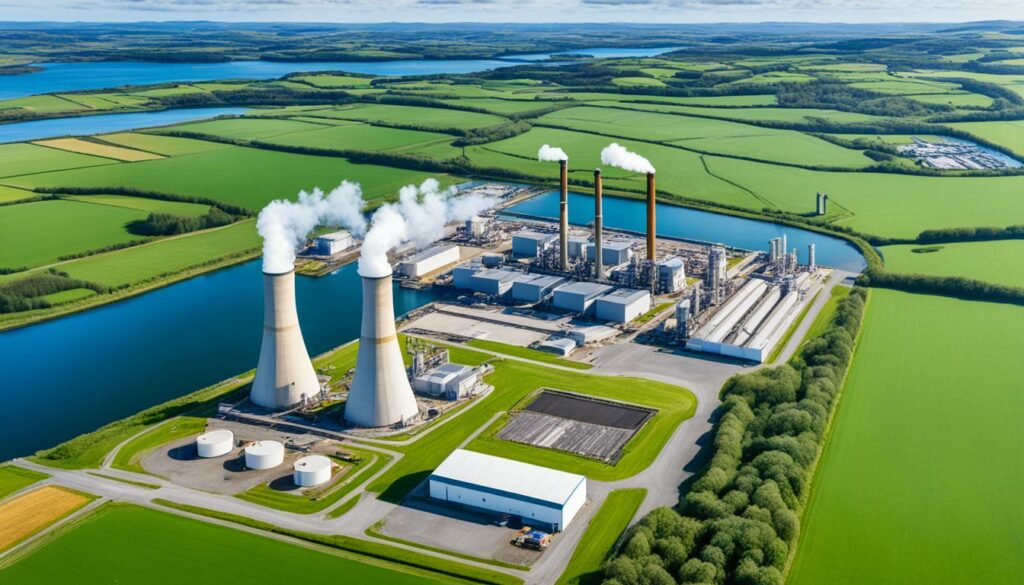
Ireland follows EU guidance by requiring separate licences for different activities. The EPA and local authorities oversee these. This method shows the careful management of environmental impacts under the integrated permitting regime Ireland.
The integrated permitting regime demands IPPC licences for operations like mining, energy, and manufacturing. The EPA ensures these are in place. The IPPC licences show the system’s focus on protecting the environment. Licences might have specific rules depending on the activity.
| Activity | Regulatory Body | Licence Type |
|---|---|---|
| Mining | EPA | IPPC Licence |
| Energy Production | EPA | IPPC Licence |
| Manufacturing | EPA | IPPC Licence |
| Waste Recovery | EPA | Waste Licence |
Looking into Ireland’s water pollution rules, it’s clear the country is serious about clean water. The nation follows EU standards carefully. These efforts are part of a bigger plan in the EU to protect the environment and people’s health. Sadly, only 40% of Ireland’s surface water is in good shape, which shows why strict rules are needed.
But, there’s good news too. Nearly 85% of places where people swim have top-notch water. This shows the rules are working well.
Ireland works hard on urban waste water, with more than 90% meeting the EU’s rules. This shows Ireland is committed to clean water. The country’s rules cover big and small operations. They also look closely at farming to reduce water pollution from nitrates.
There’s a group in Ireland working hard on zero pollution. The goal is to make sure water rules always aim for zero pollution. This shows Ireland is serious about keeping water clean and following EU standards.
Here’s Ireland’s main water pollution facts:
| Parameter | Statistic |
|---|---|
| Surface water bodies achieving good ecological status | 40% |
| Bathing water sites of excellent quality | 85% |
| Urban wastewater treated according to EU standards | 90% |
These facts show why Ireland keeps working hard on water pollution. The EU wants to be climate neutral by 2050. This makes Ireland even more determined to protect its water. It works closely with the EU to have strong water rules. These rules help fight pollution now and in the future.
Ireland takes EU environmental rules very seriously. This shows its strong commitment to a green future. It has many laws to handle the impact on the environment. Acts like the Environmental Protection Agency Act (1992) show how much Ireland respects these rules.
The country follows EU directives to reduce emissions. The EU wants to lower greenhouse gas emissions by 55% by 2030. Ireland is working hard to achieve this goal.
It is also working on reaching the EU’s biodiversity goals. This means restoring much of Europe’s natural areas by 2030. It’s also pushing for sustainable food practices through the Farm to Fork Strategy.
The EPA is in charge of making sure these eco rules are followed. It gives out important licences for pollution prevention and waste control. Not following these rules can lead to big fines or even prison in Ireland.
Groups like An Taisce and Friends of the Irish Environment help push for strong green policies. The Just Transition and Social Climate Funds are there to support those hit by changes in the energy sector. They aim to make Ireland’s move to a greener economy fair for everyone.
In the end, Ireland’s work with the EU on environmental issues is a mark of its proactive nature. This shows its strong commitment to preserving the environment and meeting climate targets.
| Measure | Description |
|---|---|
| Greenhouse Gas Reduction | 55% reduction by 2030 |
| Biodiversity Strategy | Restore 80% of ecosystems by 2030 |
| Regulatory Enforcement | EPA’s role in issuing and regulating licences |
| Penalty System | Fines up to EUR 15 million and potential imprisonment |
| Support Funds | Just Transition Fund and Social Climate Fund |
Looking back on Ireland’s journey in caring for the environment, it’s clear they take it seriously. They have followed strict EU rules, showing a real commitment to protecting our Earth. Ireland’s path shows that caring for the environment is good for the economy, too.
The growth in jobs and the economy tells a positive story. The number of services jobs has gone up, as has their quality. This is seen in the rise of what people earn. The country has shown that protecting nature and doing well economically can go hand in hand.
Ireland’s success in trade also impresses. They used to buy more than sell but now do really well in selling. Their trading with the EU is a major part of this success. It’s helped them make a lot of money and create a lot of jobs. This is proof that working closely with the EU has big benefits.
Efforts like Erasmus+ and the CAP show the strong help the EU gives. These programmes help people learn, work, and improve the land. In addition, funds for Ireland’s ESF+ programme support training and learning. This effort makes sure Ireland’s workforce is ready for a green future.
This balance of protecting the environment and growing the economy is a model for others. With access to the Single Market, Irish farmers have reached new heights, and rules on waste have made things better. The progress shown by these efforts proves that a green, rich world is not a dream but within reach. With this teamwork, we can make a world that’s better for everyone.
Ireland works closely with the EU to make sure its environmental policies help in the effort to save our planet. This shows Ireland’s promise to work with other European countries to keep the environment safe.
The European Green Deal is a big plan by the EU to stop climate change by 2050. It includes fixing damaged ecosystems, making our food systems better, and growing our economy the smart way.
The EU wants to fix 80% of nature in Europe by 2030 with the Nature Restoration Law. This is very important for Ireland as it helps protect our plants and animals, making sure they can live and grow well.
The Farm to Fork Strategy wants to change how we make and eat food. It aims for food that’s good for us, fair to everyone, and doesn’t run out. Ireland is working hard to make this happen.
The ‘Fit for 55’ plan is to cut how much harmful gas we make by at least 55% by 2030. This affects everything from businesses to how we travel, all to help the planet.
Ireland is putting a lot of effort into making more clean energy and using less gas. It aims to cut emissions a lot by 2040, to be better for the planet.
They help make moving to a green economy fair, so everyone wins. Ireland uses these funds to make sure the change to greener ways is good for everyone.
Ireland, along with the EU, made a promise to help stop climate change with the Paris Agreement. This shows the world Ireland is serious and leading in the fight against climate change.
Laws about air and water quality from the EU, and considering the environment in big treaties, have shaped Ireland’s approach. These rules have made Ireland’s environmental efforts stronger.
The EU’s plan to tackle big issues like climate change inspires Ireland. It helps Ireland plan for a future where we can still enjoy our planet, with the right steps now.
Ireland has important laws like the Environmental Protection Act. These laws make sure we look after the environment and everyone living here well.
In Ireland, the EPA and local groups make sure we keep to environmental laws. They help make sure we do our part to protect the environment as the EU wants.
The EPA and the law make sure everyone follows environmental rules in Ireland. They keep a close eye on how we help the environment, as we should.
Groups like An Taisce and Friends of the Irish Environment push for stronger eco-laws. They make sure our local efforts to save the planet meet EU’s standards.
In Ireland, the EPA handles permits that look at all the ways we impact the environment. This helps make sure the rules are followed well, as the EU says.
Ireland closely follows the EU’s high standards to protect our water. It uses special permits and local permissions to keep our water clean and safe for everything that lives in it.
Ireland makes and follows many laws to keep up with the EU’s green goals. It’s part of big plans like the European Green Deal, showing Ireland really cares about the environment.